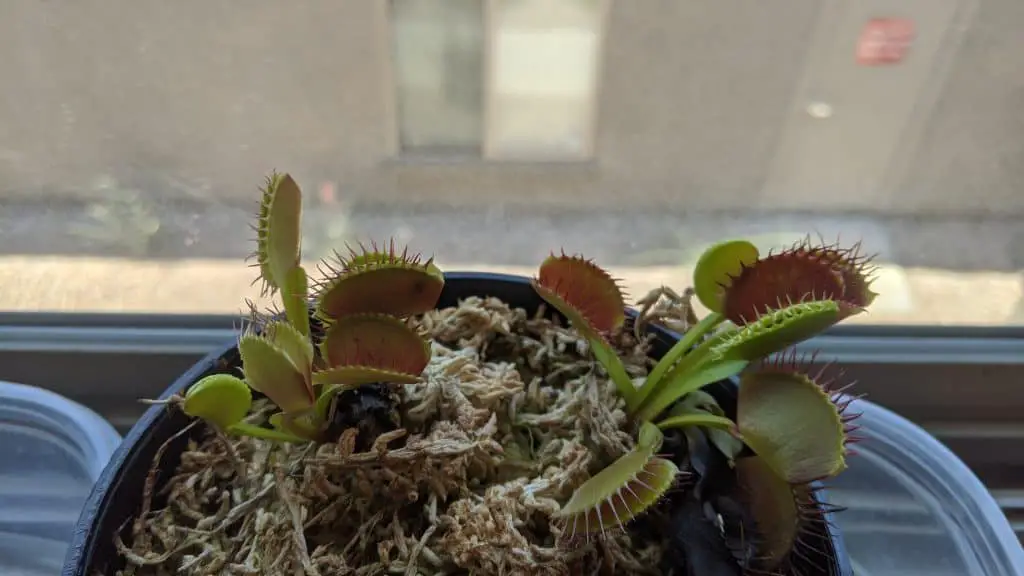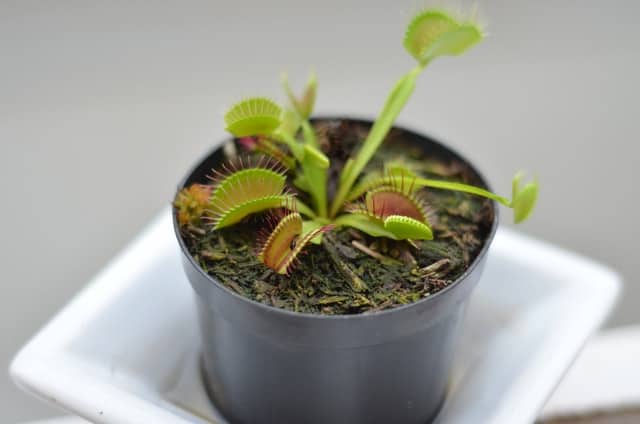I live in Phoenix, Arizona, and at my home, I have grown Venus flytraps for several years. Arizona is a beautiful state, but high heat during the summer can be a challenge when growing Venus flytraps. I would like to share with you some care considerations and tips to grow Venus Flytraps in Arizona and overcome the extreme heat conditions.
Venus flytraps can be grown outdoors in Arizona, where summer temperatures often surpass 110F. However, in this high heat environment, growers must take additional considerations such as placing Venus flytraps under partial shade, using appropriate potting containers and keeping a high humidity environment.
Even though Venus flytraps can be grown outdoors in high-temperature environments (such as Arizona), it is still a challenge. You must be careful about building a setup. Your setup will need some shading and cooling mechanisms to prevent your plant from drying out.
The next sections will guide you through the process on how to ensure your Venus flytrap lives healthy through the hot summer.
Grow Venus Flytrap in Arizona
In the wild, Venus flytraps live through high summer temperatures between 75° F and 95° F. These plants are native to South Carolina and North Carolina in the United States. If you have visited those states, you might be familiar with the hot summer weather.
Venus flytraps require plenty of light. Most care guides suggest a minimum of 8 to 12 hours of sunlight. Sunny weather is a perfect fit for Venus flytraps. However, you must always remember that areas with high sunlight indexes tend to get hot and this can be a problem for your plant.
Optimally, you must keep your Venus flytrap’s habitat between these temperatures:
- Summer temperature suggested maximum: 95° F (35° C)
- Winter temperature suggested minimum: 30° F (-1° C)
Even though Venus flytraps are resilient plants, they can be greatly affected by intense heat. In Arizona or in any other location where temperatures surpass 95° F (35° C), you must use preventative measures to lower the temperature of the plant, its soil, and pot.
When growing your Venus outdoors, consider placing your plant in a strategic location where it is only exposed to indirect sunlight. Your plant will still need enough lighting, but over 8 hours of indirect sunlight should be enough to keep your plant healthy.
Also, you can consider placing your plant in a hybrid environment. There it can get a few hours of direct sunlight and plenty of indirect sunlight through the rest of the day.
5 Tips to Overcome High-Temperature Environment
The following list includes five different options to keep your Venus flytrap healthy through the summer. All five are alternatives to lower heat exposure.
- Use a shade cloth to decrease sun intensity
- Avoid placing your plant behind glass or a glass container.
- Choose plant containers that insulate.
- Keep a high humidity index.
- Consider growing Venus flytraps indoors
Now, lets explain each of them:
Tip 1: Use a Shade Cloth
A Shade Cloth is a loosely woven piece of cloth made of polyester or a similar material. People use them to get protection from the sun. Shade Cloths or Sun Shades are handy for home gardening and greenhouses.
You can employ a Shade Cloth to provide partial shade for your Venus flytrap during the summer.
There are many different degrees of Shade Cloth. When you buy one, you can choose between 5% and 95% density. For your Venus flytrap, I would suggest somewhere between 20% and 50% if it is going to be placed outdoors during the summer. The actual percentage will depend on the specific placement of your plant.
I always suggest trying a higher density when in doubt (so you don’t burn your plant). If the temperature under the shade is appropriate but your plant is weakening, then it is not receiving enough light. Now, you can try a lower density.
You can buy shade cloth in department stores, hardware stores or online. Here is a link if you are buying a shade cloth online: Sun Block Shade Cloth .
.
Tip 2: Avoid Windows and Glass
Glass can magnify the intensity of the sun and raise the temperature next to it. And this type of heat can certainly dry out your plant very quickly. Generally follow these practices:
- Do not use a glass pot or container for your Venus flytrap: it will only increase the temperature even more.
- Do not place Venus flytraps behind an extremely sunny window: monitor the glass’s temperature during a hot day before placing your plant behind glass.
- Never place Venus flytrap terrariums outside in the summer: the full glass enclosure will raise the container’s temperature and burn your plant.

Venus fly trap Window Placement
Tip 3: Chose the Right Pot
The material of your plant container or pot can affect the temperature of your plant and the soil.
As mentioned in the previous Tip 2: “Avoid Windows and Glass”. Glass pots are not recommended. Also, metal containers can raise the temperature of your plant.
The best options for growing Venus flytraps in high temperatures are terra-cotta or ceramic pots. And for one step further, choose light color containers.
Tip 4: Water Reserve Strategy
Humidity can help lower the temperature. Venus flytraps do not require extremely high humidity levels, but they are used to humidity above 50%.
You can raise the humidity level of the environment by using a plate or container full of water.
Like in the image below, you can place your Venus flytrap pot on top of a container. Then, add some water to the container. Since the pot has openings in the bottom, the soil will always be moist, and the humidity will remain high.
Avoid filling the whole outside container with water. Generally, Venus flytraps grow better when there is a small amount of standing water, not large amounts.
Tip 5: Grow Venus Flytrap Indoors
Sometimes people feel like it is too difficult to place Venus flytraps outdoors due to environmental conditions. In that case, there is an easy solution to consider: grow your Venus flytrap indoors.
Venus flytraps can be grow indoors as well as outdoors.
I prefer placing my plants outdoors because they catch their own prey and are exposed to natural lighting, but it is not a requirement. You can set your plant near a sunny window (remember, not to close!). There, they can get enough light while remaining at room temperature.
Also, you can grow your Venus flytrap indoors without natural light. Venus flytraps can grow healthy with artificial lighting.
Plant lights are an excellent option to provide a stable light source. High-output fluorescent lights are optimal for Venus flytraps.
Venus Flytrap Care Considerations
Besides the temperature requirements, you still need to consider several other factors to care for your plant. This list is a short summary of Venus Flytrap care considerations.
Water: Venus flytraps need to be watered very often (here is a guide on watering that can help you use the optimal amount) (here is a guide on watering that can help you use the optimal amount). The soil should always be moist. In Arizona, this can be a challenge. For that reason, I always use the water reserve strategy (Tip 2)
Also, you can’t water Venus flytraps with tap water, instead use rainwater, reverse osmosis water, or distilled water.
Light: Venus flytraps require plenty of sunlight. You must place them in a spot where they can receive at least 4 hours of sun a day.
If you do not have access to natural light, employ artificial lighting: high output fluorescent lights.
Feeding: Venus flytraps need to consume bugs to grow and develop. Outdoors, Venus flytraps catch their own prey. But, indoors, you will have to do the feeding. Here is a guide if you are unfamiliar with the process: Venus Flytrap Feeding Guide .
.
Trimming: Routinely, the traps of your plant will wither as new ones grow. When the traps die, they change in color and turn black. You can trim your plant by cutting the dead leaves.
Do not pull the dead leaves, use a small plant pruner or scissors. Also, avoid activating the trap while handling the plant.
Soil: Venus flytraps require nutrient-free soil with good drainage. You can buy a carnivorous plant soul mix of make one yourself. For the DIY strategy, combine long-fibered sphagnum moss or sphagnum peat moss with sand or perlite.
Fertilizer: There is no need to fertilize Venus flytraps.
Final Thoughts
It is possible to grow Venus flytraps anywhere in the world. You can grow them indoors if you live through challenging environmental conditions. Or perhaps, you can grow them outdoors, but adapt to the circumstances.
You must always remember that Venus flytraps need several key elements to survive. Make sure you are fulfilling all the care considerations to let your plant thrive.
I hope you enjoyed this article. Have fun growing Venus flytrap!
Sources
- D’Amato, P. (2013). The Savage Garden. Berkeley, Unites States: Ten Speed Press.


